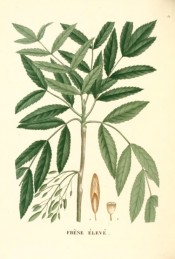Fraxinus excelsior L.
Fully-hardy, vigorous, spreading, deciduous tree with conspicuous black buds in winter, pinnate leaves, to 30cm long, composed of 9, 11, or 13 leaflets, which turn yellow in autumn. To 30m. [RHSE, Hortus, Hilliers’].
Horticultural & Botanical History
An ancient garden plant. ‘A common tree in our hedges and woods. The bark of the branches is grey, and the leaves are winged; the small ones of which they are composed are oblong and dented. The flowers are of a whitish green, and come before the leaves: the seeds are what they call ash-keys, these ripen in September. The bark of the young branches is good for obstructions of the liver and spleen, and therefore is of great service in dropsies, jaundice, and other complaints of that origin: it works by urine. The seeds have the same virtue, but in a less degree.’ [Hill p.16/1812]. Saint-Hilaire Arb. pl.32/1824.
History at Camden Park
Listed in all published catalogues [T.459/1843].
Notes
Fraxinus excelsior Boiss. (1839) = Fraxinus angustifolia Vahl
Fraxinus excelsior Walter (1788) = Fraxinus platycarpa Michx.
Fraxinus excelsior Bove ex A.DC. (1844) = Fraxinus oxyphylla M.Bieb.
Published Feb 16, 2009 - 05:33 PM | Last updated Jul 28, 2010 - 02:36 PM
| Family | Oleaceae |
|---|---|
| Category | |
| Region of origin | Europe |
| Synonyms | |
| Common Name | Common ash |
| Name in the Camden Park Record | Fraxinus excelsior - Ash tree |
| Confidence level | high |


